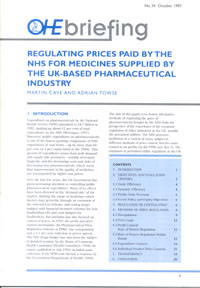Unlocking the Value of Combination Therapies

The aim of this paper is to review alternative methods of regulating the price of pharmaceuticals bought by the NHS from the perspective of the experience of the economic regulation of other industries in the UK, notably the privatised utilities. The NHS procures…
The aim of this paper is to review alternative methods of regulating the price of pharmaceuticals bought by the NHS from the perspective of the experience of the economic regulation of other industries in the UK, notably the privatised utilities. The NHS procures medicines in a variety of ways, subject to different methods of price control, but the main control is on profits via the PPRS. The emphasis in privatised utility regulation in the UK form of an RPI-X price control (combining an increase for inflation with an efficiency target) and, where possible, the creation of market conditions which allow competition and so reduce or remove the need for regulation. Table 1 gives an overview of utility regulation. There has been a widespread assumption that profit control based on ‘cost-plus’ regulation is less effective in getting value-for-money for the consumer because it does not create the same incentives for efficiency. As the current PPRS is due to expire in October 1998 it is timely to consider whether experience elsewhere suggests it should be replaced by a different type of regime.
The paper evaluates the PPRS scheme against possible alternative types of economic regime, given the assumptions underlying UK privatised utility regulation and competition policy. The experience of other major European countries in regulating pharmaceuticals is also considered. It is structured as follows:
• Section 2 outlines the objectives we believe appropriate for price control regimes in general, and pharmaceuticals in particular;
• Section 3 sets out the types of price control methods used in the utility sector and the nature of the implicit contract between the regulator and the companies;
• Section 4 then examines whether these alternative price control regimes could be efficiently applied in the case of pharmaceuticals, looking at overall price levels and, drawing on experience of pharmaceutical regulation elsewhere, relative price levels;
• Section 5 discusses the transparency with which the current PPRS scheme operates;
• Section 6 gives our conclusions.
Regulating Prices Paid by the NHS for Medicines Supplied by the UK-Based Pharmaceutical Industry
